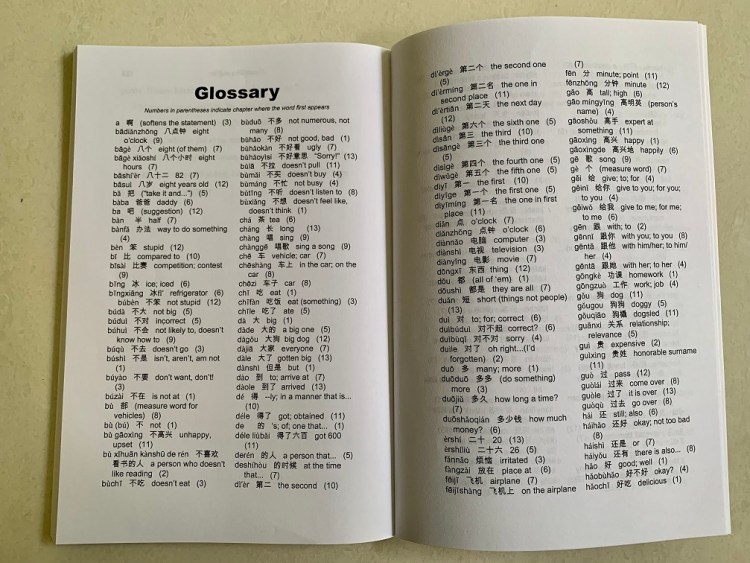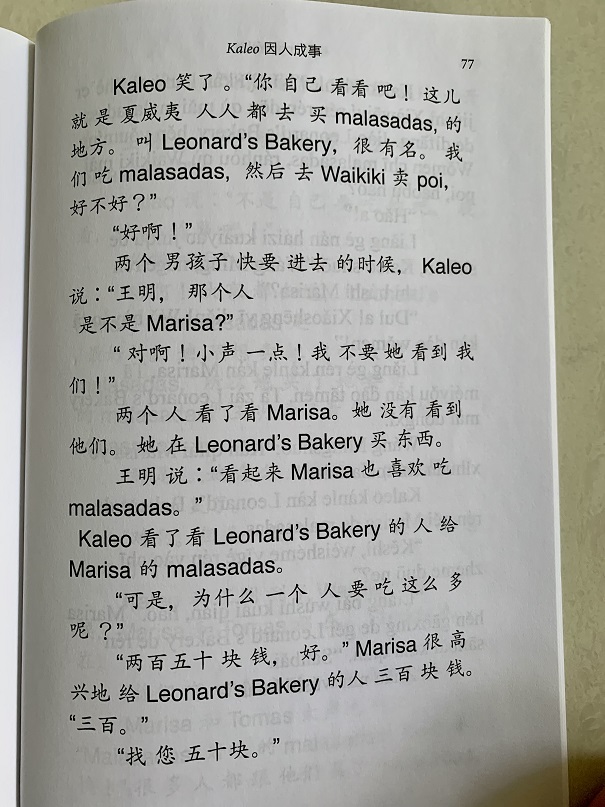This review looks at the Squid for Brains Readers (also called Mandarin Chapter Books) published by none other than Squid for Brains. These are different from the Squid for Brains Picture Books which I’ve reviewed earlier, however the Readers are just as zany and unique.
One thing I try really hard to do with this blog is to share content about resources which have been helpful to our family and for which very little information exists; this Squid For Brains series is certainly one of those gems.
Key Information on Squid for Brains Chapter Books
- Series name: Squid for Brains – Readers
- Author: Dr Terry Waltz
- Number of books in set: 5
- Number of lines per page: ~ 20
- Number of pages per book: 90 – 120
- Total length of the book: 8000 – 11,000 characters
- Characters required by child to read it independently: The easiest book consists of 175 unique characters. If a child knew ~1000 characters total, there’s a good chance that they’d be able to read nearly everything.
- Pinyin: Yes, and it’s kept on different page from the characters
- Bilingual: No
- Available in Singapore NLB: No
- Original language of publication: Chinese (also available in Spanish)
- Characters: Traditional and Simplified versions
- Audio available: No
- Suggested ages: 10+
Background to Squid for Brains Chapter Books
Squid for Brains is the brainchild of Dr Terry Waltz, a talented translator, interpreter and language educator extraordinaire. The intent of all Dr Waltz’s books is to have readable and accessible content for students learning Chinese as a second language. The books are cemented in the theory of comprehensible input to gain fluency in a language, and having meaningful literature for beginners (for older children and adults, especially).
Comprehensible input in Chinese is a rare genre – it means purposefully written books for an older learner, that are more interesting and longer than children’s literature, but deliberately simpler in vocabulary. As a Chinese language teacher of 30+ years, Dr Waltz has written these books for use in her middle school and adult classes and has mastered this type of literature.
Specifically these Chinese Readers focus on high-frequency vocabulary used during year 1 of most American middle school / high school Chinese programs.
Synopsis of Squid for Brains Simplified Chinese Readers
- Milo: 175 unique characters. Milo and his friends from the Robotics Club are hoping to take part in a competition, but there is some drama among the cool kids
- Susan: 207 unique characters, and the first chapter itself only has 23, which means a student in their first month of learning Chinese could attempt it (with quite a lot of help……). About a crazy teen girl called Susan and what she gets up to.
- Tom: 369 unique characters. Tom is a boy struggling with romance, chores and family life. You’ll be surprised!
- Kaleo: 375 unique characters. When Kaleo’s parents disappear at the Bermuda Triangle and he moves in with his uncle in Hawaii, an adventure of a lifetime unfolds.
- Josh: 417 unique characters. Josh is picked on at school by a bully and busy at the family dairy farm after school. Drama arises when a new girl joins his school. (to be honest, the books start getting quite hard by this point).
What my daughter likes about the series
- Simpler text with a complex story at an age-appropriate level – reading Peppa Pig in Chinese as a tween/teen isn’t at all interesting, but reading Harry Potter in Chinese is still a long way off. Squid for Brain Chapter books are a great in-between, on the easier side, but encouraging a child to keep reading for pleasure at an age-appropriate level. They work well for adults too.
- Use of translanguing – For names of people, places, foods, tv shows etc some of the books use English interspersed between the characters (eg Cheesy Tuna Surprise, Tennessee Fried Chicken, PowerBall. This brings the narrative to life more for a beginner.
What a parent will like about Squid for Brains Simplified Chinese Readers
- No pinyin beside the characters, but there is a glossary at the back and pinyin on the reverse page – A general pet peeve of mine is any beginner book that contains pinyin above the characters. Squid for Brains books are free from this.
- Limited yet relevant character count– you can buy these books with more certainty that your child actually will be able to read them and learn a handful as new characters too. It will also likely take them quite a way to chew through the books, so it’s like a mini-project for them.
- Matching syllabus – A teacher or homeschooler would appreciate that are some card games and other teaching resources that coordinate directly with these novels, to allow vocab practice. These are also available from Squid for Brains.


Insides of the Squid For Brains Readers




Some watch outs and considerations
- Variability across the series: Not all the books are equally funny – in fact, my daughter flat out said some are boring. Some of the formatting and style differs across books too, as it feels like the individual books have been written over many disparate years (which I think is possible true look at the book imprints …. They differ from 2012 to 2016)
- Humour is targeted for older readers and has a very American slant: some of the pop culture references and puns are only punny if you’re American and get that type of satire.
Where to buy Squid for Brains Chinese books
I bought ours direct from Squid for Brains website. There are some copies on Amazon and other online bookstores, but largest variety is at the author’s website herself.
If my child likes this, what are other similar books in Simplified Chinese?
Some books which my children have enjoyed at a sort-of-similar reading level are:
- Mandarin Companion series (review here) – these books also used the ‘comprehensible input’ pedagogy, and retail classic tales in simple text. The ‘Breakthrough Level’, starts out with 150 unique characters. These too would work for teeangers/adults as the storylines are more rewarding, and the themes more grown-up in nature.
- Zoroli series (review here) – these are more of early readers mixed with comics. They’re not written with a limited character count, but on the whole are quite simple.
- Mi Xiao Quan series (review here) – this is a household name in mainland China, a bit like the equivalent of Diary of Wimpy Kid in English. Good for a child trying to build up their reading muscles.
- Chinese Graded Novels: Books for not-quite-beginners – this post compares four other book series which are written as novels for older beginners to try (not nearly as funny as Squid for Brains, but similar in their length and difficulty level)
I hope you found this introduction to Squid for Brains Readers helpful. I would also love to know what other books you think are great at this same emergent reader level for older children. Please share any ideas below. I”d love for this page to be a resource to sharing other book at a similar level.

